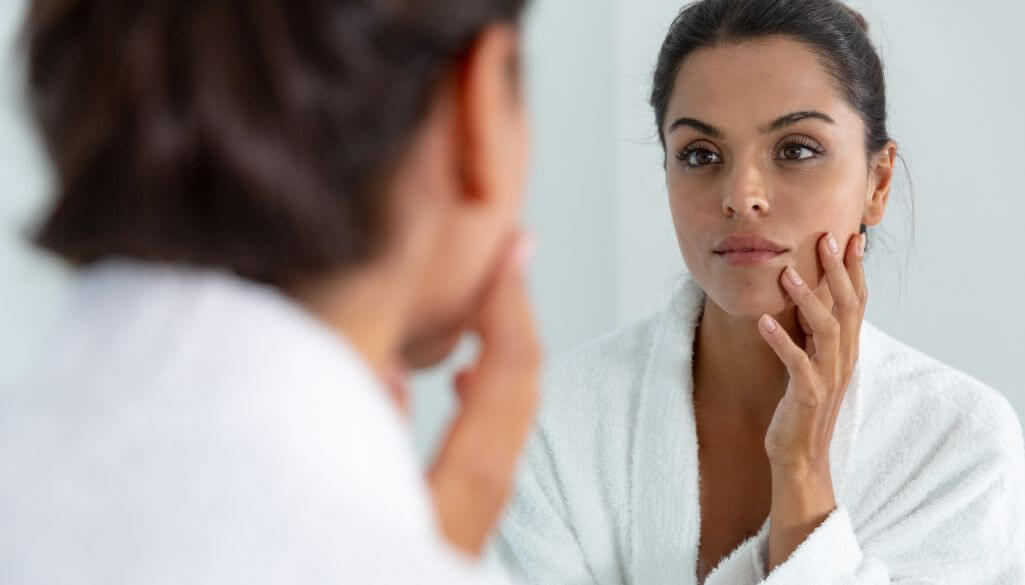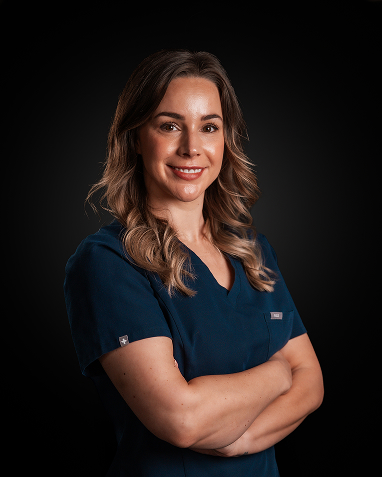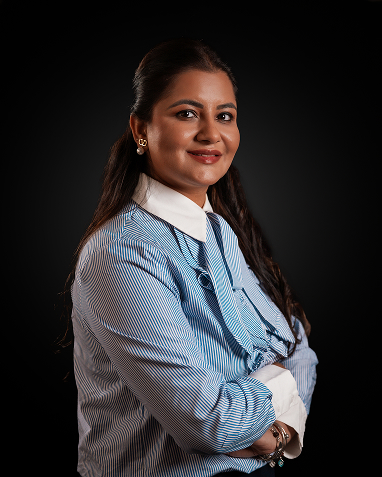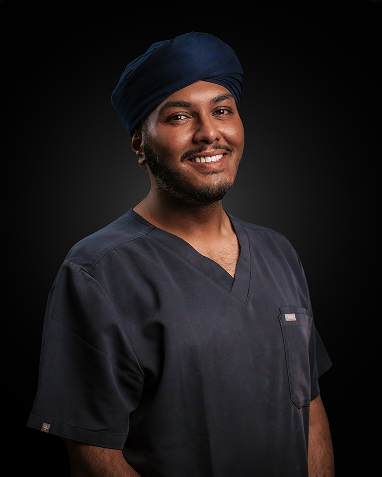Sallow skin refers to a little dull, yellowish tint that makes your face look tired instead of fresh. It can happen slowly over time, and many people don’t notice it at first.
But when your skin loses its natural glow, it’s often a sign of stress, lifestyle habits, or sometimes even health concerns.
If you‘re looking for a bright side, this blog is for you!
With simple changes and the right care, you can bring back a healthy, radiant complexion. Let’s explore all about sallow complexion, from its causes to treatment, everything.
What is Sallow Skin?
The term ‘sallow skin’ means skin that looks dull, tired, and slightly yellow or brown in tone. Instead of a fresh, healthy glow, the skin may appear flat or uneven.
A sallow complexion can happen on any skin type, but it shows up differently depending on your natural tone. On fair skin, it often looks pale-yellow. On olive or medium skin, it can look more brownish or muddy.
It’s essential to note that sallow skin refers to a distinct condition, distinct from normal ageing. While fine lines and dryness are expected over time, sallowness is usually linked to things like poor sleep, smoking, dehydration, or even vitamin deficiencies.
What Causes Sallow Complexion?

While it is not the same as natural ageing, many habits and health issues can speed up dullness and a yellow-brown tone. Here are the most common causes:
Missing vitamins like B12, C, and E slow skin repair and collagen production. Without enough nutrients, the skin becomes uneven, weak, and unable to fight free radical damage. This leads to dullness and a yellow-brown tone commonly seen in sallowness.
Anaemia lowers oxygen delivery to the skin, leaving it pale or yellowish. The lack of healthy red blood cells makes the complexion look weak and dull. This condition often shows alongside fatigue, giving skin a tired and lifeless appearance.
Too little water leaves skin dry, less elastic, and dull. When you are dehydrated, the skin cells cannot function well, creating a rough texture. Drinks like caffeine and alcohol worsen the problem, making sallowness more noticeable alongside tired, flaky skin.
Nicotine narrows blood vessels, cutting off oxygen and nutrients to the skin. It breaks down collagen and elasticity, speeding up wrinkles. Skin takes on a yellow tint, looks lifeless, and often appears prematurely aged with sallowness.
A poor diet lacking vital nutrients, such as vitamins B12, C, and E, weakens skin repair and collagen production. Over time, the complexion appears uneven, tired, and yellowish, as missing antioxidants fail to protect against dullness.
Skin restores itself overnight, repairing damage and renewing cells. Poor sleep disrupts this process, leaving skin flat and uneven. Ongoing tiredness deepens sallowness, often appearing with under-eye darkness, fine lines, and a tired, yellowish tone.
Chronic stress increases cortisol, harming circulation and raising inflammation. With fewer nutrients reaching the skin, the complexion becomes dull and lifeless. Over time, sallowness appears more clearly, marked by a weak, flat, yellow-brown tone.
Neglecting cleansing, exfoliation, and sun protection allows damage and dead cells to accumulate. Skin looks patchy, flat, and less radiant. Without moisturising, dryness worsens sallowness, weakening the skin’s natural glow and smoothness.
Long-term sun exposure weakens collagen and elastin, resulting in thinner, less supple skin. UV rays also trigger uneven pigmentation, causing a dull, yellow or brown tint that contributes to the appearance of sun-damaged skin and sallowness.
As skin ages, cell turnover slows and collagen production reduces, leading your skin to become thinner and less elastic. Combined with sun exposure, this can lead to dryness and dullness. A yellowish tone often develops, making sallowness more visible over time.

Ready to achieve your aesthetic goals?
- CQC-Registered Clinic with Nationally Recognised Leadership
- Over a Decade of Surgical & Aesthetic Expertise
- Personalised treatment plans tailored to your needs
What Does Sallow Skin Look Like?
Sallow skin can show up in a few different ways, and it often depends on your natural skin tone. Here are some common signs people notice:
- Yellow or brown tint: Skin looks less bright and takes on a yellowish or muddy tone.
- Dullness: Instead of reflecting light, the skin looks flat and tired.
- Dryness and rough texture: Sallow skin often feels flaky or uneven.
- Tired appearance: Even if you’re rested, the skin may give off a fatigued look.
Some people describe it as looking like the skin has “lost its life.” Unlike a healthy glow that feels fresh and vibrant, a sallow complexion makes the face appear older or less energised.
Can Dark Skin Be Sallow?
Yes, sallow skin can appear in darker skin tones, but it may look a little different compared to lighter skin. Instead of showing as a yellow tint, sallowness in darker complexions often looks like:
- A brownish or greyish cast over the skin.
- An overall dull or flat look, where the natural glow seems faded.
- Areas of uneven skin tone or patchiness.
Because darker skin has more melanin, sallowness may not always be obvious at first glance. Instead of clear yellowing, it often shows up as the skin looking tired, shadowy, or lacking radiance.
Who Has Sallow Skin?
Sallow skin can affect almost anyone, but it is more common in certain groups, including:
With ageing, the cell turnover slows down, and dead skin cells build up, making the skin appear dull, uneven, and yellowish, leading to a sallow look.
People with Nutritional Deficiencies
Individuals who do not take vital vitamins and minerals, especially B12, C, and iron, often experience skin that lacks oxygen and nourishment, leaving it flat, tired, and sallow.
Smoking restricts blood flow and reduces oxygen, causing skin to lose its glow. Over time, it looks pale and grey and develops a sallow tone.
Those Under Stress or Lacking Sleep
Stress hormones and poor sleep slow repair and weaken circulation. This makes skin look tired, lifeless, and more likely to appear sallow.
Health issues such as anaemia, liver disease, or chronic illness can affect blood circulation or skin tone, resulting in a persistent sallow and dull complexion.
How is Sallow Skin Diagnosed?
Your doctor may diagnose sallow skin complexion with the help of:
- Visual check: Skin looks pale, yellowish, or dull.
- Lifestyle questions: About diet, sleep, smoking, or stress.
- Blood tests: To rule out anaemia, vitamin gaps, or health issues.
- Skin care review: Daily habits, hydration, and sun exposure are considered.
What are the best Sallow Skin Treatments?
If you have tried home remedies but your skin still looks dull, experts offer safe treatments that go deeper, restore radiance, and help speed up results. Professional treatments include:
During a chemical peel, a safe solution made from natural or medical acids is brushed onto your face. It gently removes old, dull skin cells and speeds up new cell growth. Depending on the strength, it can soften fine lines, fade dark patches, and bring out a clear, glowing complexion.
Ultraclear Laser Resurfacing
UltraClear laser resurfacing works by removing damaged outer layers while heating deeper layers to spark fresh collagen production. Unlike older lasers, it’s designed to be gentler with faster recovery. It helps tackle dull tone, fine lines, and uneven texture, leaving skin with a renewed glow.
NeoGen plasma therapy works by utilising a controlled plasma energy to heat skin gently, without damaging the surface. It helps trigger natural cell renewal, boosts collagen, and tightens loose areas. Over time, skin looks smoother, brighter, and healthier, making it a great option for tackling sallowness and early ageing signs.
It is an amazing therapy to kill toenail fungus permanently.
Profhilo is an injectable moisturiser made of pure hyaluronic acid. Instead of filling wrinkles, it spreads under the skin like a “water net,” deeply hydrating and remodeling skin from within. The result is softer, bouncier, and more radiant-looking skin, without changing your natural face shape.
This treatment uses very fine needles to create tiny micro-holes in the skin. These small “injuries” push your body to repair itself by making more collagen and elastin. As the skin heals, it becomes smoother, firmer, and looks more awake, with sallowness and dullness fading over time.
Apart from sallow skin, if you want to know how to shrink pores permanently, know that microneedling helps there, too.
IPL uses gentle bursts of light that target deep under the skin. It helps break down uneven pigmentation, stimulates fresh collagen, and encourages healthier blood flow. Over a few sessions, skin often looks brighter, more even, and youthful.
What Skincare Routine Can Help Improve Skin Sallowness?
A simple skincare routine can do wonders to bring back your skin’s natural glow and reduce that dull, yellowish tone.
Use a soft, hydrating cleanser twice a day. This clears away dirt, oil, and pollution that can make skin look tired, without stripping away moisture.
Exfoliation (2-3 Times a Week)
Use a mild chemical exfoliant like AHAs (glycolic or lactic acid). It will sweep off dead, dull skin cells and allow fresher, glowing skin to show through.
Apply a serum with vitamin C in the morning to wake up the skin and even the tone. At night, niacinamide or a gentle retinoid can help smooth texture and fade sallowness.
Lock in hydration with a good moisturiser suited to your skin type. Look for ingredients like hyaluronic acid, ceramides, or glycerin to plump skin and support its barrier.
Make sunscreen a must, even on cloudy days or when you’re indoors near windows. A broad-spectrum SPF 30 or higher keeps skin safe from sun damage that worsens sallowness.

Ready to achieve your aesthetic goals?
- CQC-Registered Clinic with Nationally Recognised Leadership
- Over a Decade of Surgical & Aesthetic Expertise
- Personalised treatment plans tailored to your needs
Once a week, use a nourishing mask with antioxidants or hydrating ingredients. Consider using vitamin E, aloe vera, or green tea to refresh and give your skin an extra glow.
With steady care and the right products, your skin can look fresher, healthier, and more radiant day by day.
How To Treat Sallow Complexion At Home?
Small daily choices can make a big difference to dull skin. Eating well, sleeping enough, and caring for your skin naturally help bring back a brighter, healthier look.
Fruits, veggies, and iron-rich meals give your skin the vitamins it needs. Foods like spinach, citrus fruits, and nuts help combat dullness and keep your skin looking vibrant and fresh.
When your body is dry, your skin looks tired too. Sipping water throughout the day helps it stay soft, plump, and glowing, while cutting back on alcohol helps too.
Sleep Like Your Skin Depends on It
Your body heals itself at night. Without enough rest, skin looks flat and lifeless. A good night’s sleep gives your face that fresh, rested glow in the morning.
Stress hormones can drain your skin’s colour. Activities like yoga, walking, or listening to music help calm the mind, lower stress, and bring back healthy-looking skin from the inside.
Smoking and heavy drinking cut off blood flow and dry your skin. Quitting these habits doesn’t just improve health; it also brings back your natural brightness and colour.
Build a Simple Skincare Routine
Gentle cleansing, weekly exfoliation, and brightening serums containing vitamin C or niacinamide help make the skin look more even. Don’t forget sunscreen; it’s your best defence against dullness and damage.
Can you Prevent Sallow Skin Complexion?
Yes, you can prevent sallow skin. Keeping your skin bright and healthy is easier when you look after your body and habits. Here are some ways to avoid sallowness:
- Eat lots of fruits and veggies every day.
- Drink enough water, and cut back on alcohol and fizzy drinks.
- Always try to get a deep, restful sleep.
- Stop smoking to give your skin more oxygen.
- Manage stress with exercise, meditation, or hobbies.
- Apply sunscreen daily to protect against sun damage.
- Stick to healthy habits; small steps make a big difference.
When to See a Doctor for Sallow Skin?
See a doctor if you have sallow skin that:
- Shows up suddenly.
- Doesn’t get better with healthy changes
A doctor visit is a must if:
- You feel very tired or dizzy.
- Your eyes look yellow.
- You’re unsure what’s causing it.
- Most cases improve once the root cause is treated.
Conclusion
Sallow skin can feel worrying, but it’s not the end of healthy skin. It’s often your body’s way of saying it needs more care, rest, and nourishment. With small lifestyle changes, good skincare, and, if needed, professional treatments, your natural glow can come back.
If you want a quick fix, consider consulting professionals for UltraClear Laser Resurfacing at Yorkshire Skin Centre in Leeds.
Remember, healthy skin is happy skin, and taking care of yourself always shows on the outside.
FAQs
1. Is Sallow Skin Unhealthy?
On its own, it isn’t always dangerous, but it can be a sign your body needs more care. Sometimes it can point to health issues like anaemia.
2. How Do You Know if You Have Sallow Skin?
If your skin looks more yellow, brown, or dull than before, even when you rest or drink water, you may have sallow skin. It often makes you look more tired.
3. Does Sallow Skin Get Worse With Age?
Yes, it can. As you age, skin turnover slows and sun damage builds up, making sallowness more likely. But with care, you can keep your skin glowing.
4. Which Vitamin Deficiency Causes Sallow Skin?
Sallow skin is often linked to low levels of vitamin B12, vitamin C, and vitamin E. A lack of these vitamins can make skin look dull, pale, or yellowish. Eating leafy greens, citrus fruits, nuts, and lean meats helps restore healthy colour and glow.


























